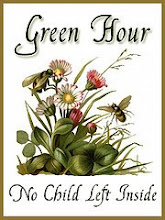Blog surfing as I do, I came across this post which had a link to this document about schemas in early childhood. A schema seems to a ‘theme’ that is particularly apparent in a childs play at a particular point in time. So, for example one of the schema is ‘transporting’ – which you will see if your child has a ‘Picking things up, moving them, and putting them down or dumping them. Perhaps using pram, bag, basket, truck or wheelbarrow. Usually has full hands’.
According to the article (which first appeared in the New Zealand Playcentre Association Journal) “Schemas are extremely useful because children's passions are what drives them to become most deeply engaged and deep engagement is what we need to identify in order to support and scaffold children's learning most effectively” It might just be me, but I think this is fascinating. Of course, it is just common sense when you look at the document – think about the things your child is really passionate about and then apply those across different areas of play.
However, being just a little bit too academic for my own good I love having a model to work with. Already today it has really changed the way I play with Munchkin. Her main ‘schema’ (it’s a dreadful word isn’t it – please someone think of a more intuitive label for it) is transporting which I mentioned above, but she’s also into ‘Enclosure and Enveloping’ - Surrounds things. Likes getting inside a defined area e.g. a block building, tyre or barrel. Gets into boxes. Covers completely, wraps up. Hides. Gets into boxes and closes lids”
So today, when I wanted to find something for her to play with at the café (wasn’t I lucky having Sunday brunch out!) I consciously thought about these two schema, and gave her some spoons, a sugar sachet and a plastic cup to hide them in. She had a ball … because I was providing opportunities for her to explore what she is passionate about. I have more consciously encouraged her ‘shopping game’ – and hours today were spent putting things in her little hand-bag and taking them around the house (transportation schema). Later this evening I set up a small table for her with some full cans of (unopened) drink, a cardboard box and a wide mouthed jam jar.
This matrix made me realise how often I try to show Munchkin things to play with that just aren’t what she is interested in – things like making sand castles or building towers (connecting) when she actually wants to fill buckets of sand, move sand from one end to the other, and then push buckets of sand around in a wheel barrow.
Schema’s aren’t a concept I’ve come across before – I am not sure if they are Playcentre specific or are used more widely in early childhood education, let alone in the Steiner/Waldorf context but I’d love to know.
Raw Cauliflower Salad
15 years ago






11 comments:
Hey there! Can you please fix the first link as it's not working at the moment and I'd love to see which blog you got the matrix from.
We use schema fairly extensively in our Playcentre - so we can talk at length about them if you so wish! I could also dig up some reading resources for you if you like.
(By the way, if you are wondering who this stranger is who is commenting on your blog, my blog title should give you a clue...:-) .).
Our centre doesn't really talk so much about schemas and I haven't done any of our workshops on it - although it does fascinate me. My ds seems to go through most of the schemas frequently (but I do notice a focus for a week or so before he moves on). DD is a lot more clear on moving in and out of the schemas.
Hello! Thanks for commenting on my blog - yours looks interesting. My son has had the trajectory schema for a very long time. He's nearly 4 now and his first word as a toddler was 'ball' - a clear indication of his interests. I tried to stop him constantly throwing things, but now I realise it's part of who he is! It's funny because he can be very quiet doing a puzzle for half an hour, and then decides that he wants to fling all the pieces in the air. He also loves jumping and falling off things on purpose. Our Playcentre doesn't talk about schema much but maybe we will as more of our members advance in their training.
I haven't seen this idea before but it sure makes sense. My son seems to be in the connecting and disconnecting schema right now. Thanks for sharing this.
aha! that could explain why my house is always a tip! alexis is a disconnecting kid 90% of the time - she tips everything out & scatters it around, then moves onto something else.. ;)
Hey thanks for this link...its great. I've not really got into Playcentre other than just letting Ara have some playtime, fun and learning.
I think once I really read through this and print it out I'll be able to keep reminding myself that its all apart of development....oh man what is not apart of it...its all so big...do you remember this as a kid?
Hi, I'm both very pleased you liked my stuff and slightly disappointed that your Passionate Play links weren't new to me.
Schema aren't Playcentre specific, New Zealand and the UK both have a fair number of researchers interested in them. Forthcoming in the next month or so from The Playcentre Association will be Nikolien van Wijk's book Getting Started With Schemas which I'm rather looking forward to.
Thanks for this info. It certainly does make a lot of sense!
Hi Gypsy, thanks for fixing the link! I'm glad it was Susan's blog and I see she has popped in too!
Some schema resources:
Athey, Chris (1980) Extending Thought in Young Children: A parent-teacher partnership. Paul Chapman Publishers: London
Meade, Anne; P. Cubey in association with A. Hendricks and C. Wylie (1995) Competent children and their teachers: learning about trajectories and other schemas. NZCER: Wellington
Meade, Anne, with P. Cubey (1995) Thinking Children. NZCER: Wellington (currently being revised for a new edition - maybe only a couple of months away from being published)
Nutbrown, C. (1984) Threads of Thinking: Young children learning and the role of early education. Paul Chapman: London.
Interesting post, as usual.
By the way, you won the draw at my weblog :-) If you're interested, email me with your mailing info and I'll send you out the gnome and little fairy.
Have a lovely day :-)
This is excellent. Lo has definitly had her various passion plays throughout her development! I'm going to check out the site and see if there are any correlations. Thanks so much for this!!
Post a Comment